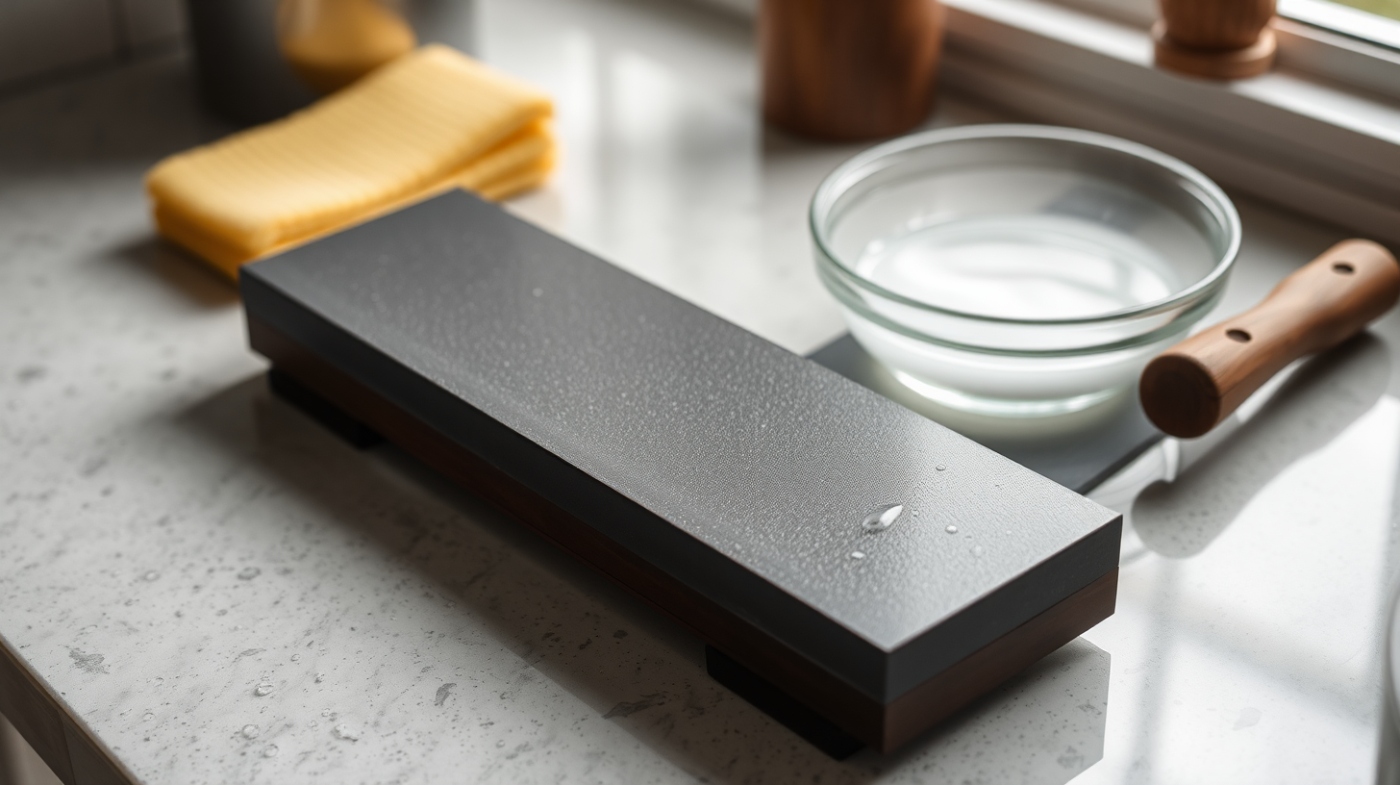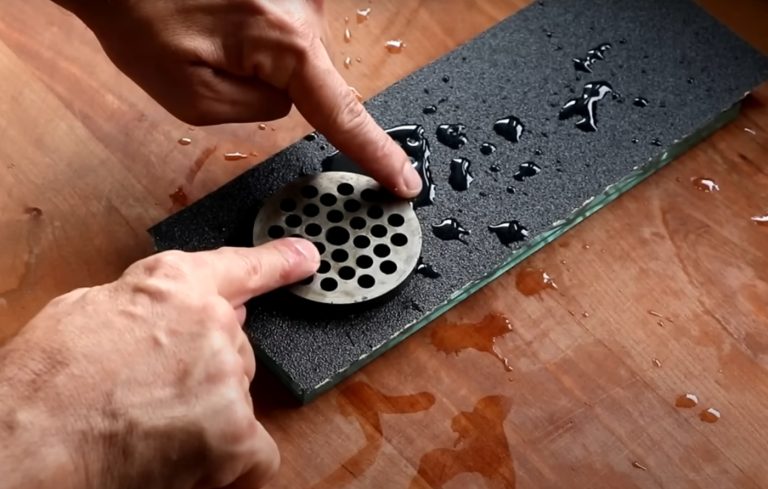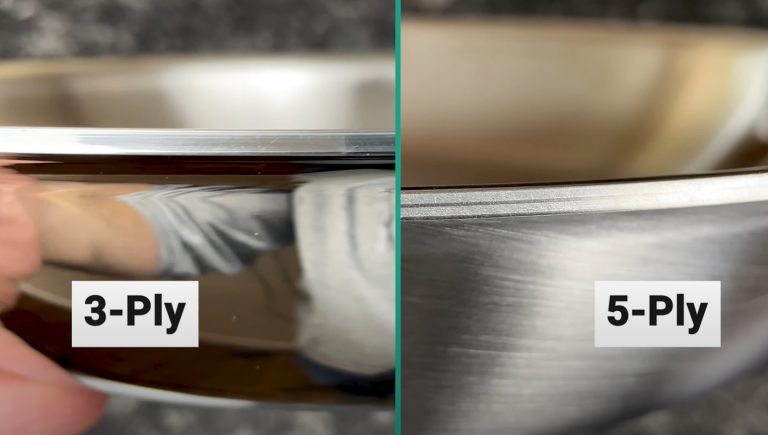How to Clean a Whetstone? Pro Tips for Lasting Performance
To clean your whetstone, start with a quarter-sized amount of honing oil, applying it evenly across the surface. Use a soft toothbrush or your finger in circular motions to lift embedded metal filings.
Rinse the stone under running water for 1-2 minutes, ensuring all debris washes away. For added grime, consider applying WD-40 and scrubbing with fine steel wool.
Always wipe the stone dry after cleaning to avoid moisture damage before storing. Regular maintenance, including flattening every 10 sharpening sessions, guarantees peak performance. Continue from here to uncover more insights into effective whetstone care.
Key Takeaways
- Clean water stones immediately after use with water to prevent particle buildup and maintain sharpness.
- For oil stones, use a quarter-sized amount of honing oil and scrub with a soft toothbrush after every 10 sessions.
- Rinse whetstones under running water for 1-2 minutes to flush out debris and ensure thorough cleaning.
- Regularly inspect and flatten whetstones every 10 uses to maintain a level sharpening surface and enhance performance.
- Avoid using soap on Arkansas stones; instead, soak in water or a mild cleaning solution if necessary.
Tools and Materials Needed for Cleaning Whetstone
Maintaining your whetstone’s performance goes beyond flattening; having the right tools and materials on hand makes cleaning an efficient process.
To guarantee you can effectively clean your whetstone, gather the following items:
- Soft brush: This is essential for gently scrubbing the whetstone surface to remove debris without causing any damage.
- Honing oil: Use mineral-grade honing oil to lift metal flecks from the stone, enhancing the overall cleaning process.
- 400-grit wet-dry sandpaper: Ideal for flattening the stone and effectively removing embedded particles.
- Damp cloth or paper towel: Necessary for wiping away residues and guaranteeing the stone is clean after applying oils or cleaning agents.
- Soapy water: A mild solution can help in the initial cleaning phase, especially for removing stubborn grime.
Additionally, always work in a well-ventilated area when using solvents like WD-40 to guarantee safety and effectiveness.
Whetstone Cleaning: Steps to Keeping It Clean
To clean and flush out mineral filings from your whetstone, follow these steps:
Applying Honing Oil
Applying honing oil is essential for flushing out mineral filings from your whetstone, guaranteeing it performs at its best. Start by applying a quarter-sized amount of honing oil evenly across the surface of the stone.
Next, use your finger or a soft toothbrush to work the oil into the stone with gentle circular motions. This action helps lift metal flecks embedded in the pores, indicating that the cleaning process is underway.
Rinsing and Drying
After thoroughly working the honing oil into the whetstone and lifting metal filings, it’s time to rinse and dry the stone properly.
Begin the rinsing process by holding the whetstone under running water for 1-2 minutes. This will effectively flush out any remaining debris and oil that may still cling to the surface of the stone. As you rinse, make sure to angle the stone to allow the water to reach all areas, ensuring a thorough clean.
Once you’ve rinsed away the excess oil and filings, take a damp cloth or paper towel and gently wipe the surface to remove any lingering particles. This step is vital for maintaining the integrity of the stone and preparing it for drying.
Now, grab a dry cloth to absorb any moisture left on the surface of the stone. Carefully wipe down the entire stone, ensuring it’s completely dry.
Procedures for Removing Dirt and Grime from a Whetstone
A clean whetstone is essential for maintaining its sharpening performance and longevity. To effectively remove dirt and grime, follow these steps to clean a sharpening stone methodically:
- Coat the surface of your stone with WD-40 to loosen any dirt and oil buildup.
- Use fine steel wool (0000 grade) to gently scour the stone, ensuring you don’t damage the abrasive surface.
- After scouring, wipe down the stone with a damp cloth or paper towel to eliminate any residues from the WD-40 and dirt.
- Rinse the whetstone under running water for about 1-2 minutes to flush out any remaining particles.
- Regular scouring and cleaning after each use can prevent significant dirt accumulation, maintaining the whetstone’s effectiveness.
Flattening Your Whetstone
Regularly flattening your whetstone is vital for ideal sharpening performance. After every 10 sharpening sessions, you should inspect your whetstone for any signs of hollows or unevenness.
To achieve even flattening, use a flattening plate or 100-grit wet-dry sandpaper adhered to a flat surface. Before you start, moisten the stone with water or honing oil. This not only enhances the effectiveness of the process but also reduces friction, allowing for smoother operation.
Begin flattening by dragging the flattening plate or sandpaper back and forth over the whetstone’s surface for about 15 seconds. This simple routine can greatly enhance the longevity and performance of your whetstone.
Make sure that you apply even pressure to achieve a consistent result across the entire stone. Afterward, rinse the whetstone to remove any residue.
Common Whetstone Cleaning Mistakes
Cleaning your whetstone effectively is crucial, but many users make common mistakes that can compromise the stone’s performance. Understanding these pitfalls will help you maintain your whetstone’s integrity and guarantee ideal sharpening results.
| Mistake | Consequence |
|---|---|
| Using oil on water stones | Damage to the stone surface |
| Neglecting to clean after use | Metal fillings embed in the stone |
| Over-soaking oil stones | Weakened structure, potential cracks |
| Using harsh chemicals | Degradation of natural stones |
| Ignoring flattening | Uneven surface, ineffective sharpening |
To avoid these issues, always use water for cleaning your whetstone, especially after sharpening. Make it a habit to clean away metal fillings to preserve its effectiveness.
If you own oil stones, limit soaking time to prevent structural damage. Additionally, steer clear of soaps or harsh chemicals; they can degrade your stone’s quality.
Finally, don’t forget to regularly flatten your stone to maintain a smooth surface essential for precise sharpening.
Frequency of Whetstone Maintenance
Maintaining your whetstone’s performance hinges on regular cleaning and inspection, ensuring it remains effective for all your sharpening needs.
By adhering to a consistent maintenance schedule, you can prevent clogging and prolong the lifespan of your stones.
Here’s a quick overview of the recommended maintenance frequency:
- Water stones: Clean immediately after each use to avoid particle buildup.
- Oil stones: Clean after every 10 sharpening sessions to keep them free from embedded debris.
- Inspect stones: Regularly check for damage or wear to prevent uneven sharpening surfaces.
- Flattening: Periodically flatten your stones every 10 uses to maintain a level sharpening surface.
- Routine cleaning: Establish a habit of cleaning your stones after each session to enhance performance.
Frequently Asked Questions
How Do You Clean a Dirty Whetstone?
To clean a dirty whetstone, apply honing oil and scrub gently with a soft brush. Rinse under running water, removing debris. For tough spots, use WD-40 and fine steel wool, then wipe with a damp cloth.
Should Whetstones Be Washed?
Yes, you should wash whetstones regularly. This practice helps remove metal filings and debris, ensuring ideal sharpening performance. Rinsing them under running water after every use enhances their lifespan and keeps them effective for your sharpening needs.
How Do You Revive a Whetstone?
Reviving a whetstone’s performance requires meticulous care. First, scrub away debris, then use honing oil for stubborn grime. Finally, flatten its surface, ensuring it’s ready for sharp, precise edges that enhance your sharpening experience.
Is It OK to Leave Whetstone in Water?
No, you shouldn’t leave your whetstone submerged in water. Prolonged exposure causes structural damage and reduces effectiveness. Instead, soak it for about 10-15 minutes before use, then dry and store it properly afterward.
Effectively Clean Your Whetstone and Enjoy Precision Sharpening
Just as a well-tuned instrument produces a beautiful melody, a clean whetstone sharpens your tools to perfection. By regularly maintaining your whetstone, you guarantee it remains a reliable partner in your crafting journey.
Each cleaning ritual is a step towards mastery, allowing your blades to glide effortlessly through their tasks. Embrace the process, and let your whetstone shine like a beacon of precision, transforming raw materials into refined creations with every stroke.







